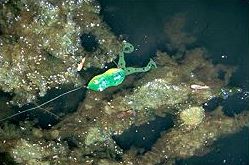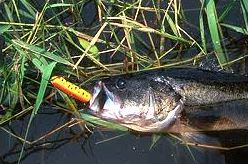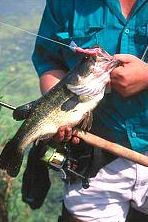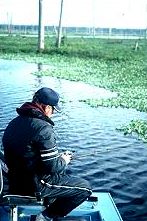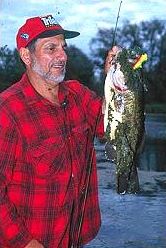
You’re bass fishing on a shallow, clear lake. It’s after 9 a.m. and the hot sun is blistering the waters. All aquatic movement seems to have come to a halt. You haven’t had a strike since the sun crept high enough to penetrate into the water. Time to go home? No way! You’ve got those bass right where you want them-in isolated areas of thicker cover.
Tens of thousands of lakes and ponds across the country have conditions that cause the bass to move shallower during hot, bright conditions. These waters often lack depth, plus they generally have little or no structure or cover below the level of light penetration. Bass usually seek refuge under the thickest light-stopping cover they can find. The cool, shaded, oxygen-rich waters under a heavy canopy of surface cover draws bass like a magnet. Plus the shaded area provides a perfect feeding situation where bass can feast “high or low” on frogs, small fish, crayfish or anything else that will fit into their large mouths. Fishing surface-blanketing cover for bass can be very productive and exciting. Surface explosions that toss floating algae, weeds and other assorted “goop” in all directions will really get your heart pumping. And when you hook a large bass it turns into more of a tug-of-war rather than a battle.
The best conditions for working surface-blanketing cover is on shallower, flatter lakes, or in shallower areas of larger bodies of water. I’ve also seen this pattern hold up on ponds, in the back ends of coves in reservoirs, bay areas in lakes, along debris-laden outside bends in slower moving rivers, even around floating bogs.
The various forms of light-stopping cover are often most productive when fishing on that particular body of water slows down. Sunny conditions usually put bass under the cover, while under lower light conditions (early or late, cloudy days) the fish tend to roam the open water or edges
OVER THE TOP
I learned the significance of floating goop to bass over 30 years ago. An old timer fished several lakes and ponds I also was working, and news of 5 to 8-pound bass he was catching out of northern Illinois waters trickled down to me. The unusual part about it was that he was going fishing when others were coming in. “The hotter the better” was his motto and he had the bass to prove it.
On several occasions I observed him fishing. He worked the thickest floating slop that collected or grew in corners of the large, clear strip pits we fished. Long casts were fired within inches of shore, and with his long spinning rod held high, he would skitter and slosh a metal spoon across the surface like something was chasing it. When he got to a pocket a brief pause would occur. And when an edge was encountered, the spoon would be allowed to flutter down several feet. Bass were usually hooked on the pauses, as it was hard for them to zero in an the fast-moving spoon.
This new found information swelled my head with new ideas. My warm weather bass fishing the next two summers pretty much revolved around where this technique would…and wouldn’t work. I remembered that several heavily fished trout ponds that charged a daily fee had a few small weed choked pockets (remember, I was barely an adult at the time). Bang, a 2 1/2 and 5 pounders the first time, plus several more missed fish. I was hooked.
Through the years the “skittering technique” has been fine tuned, even to the point where a spoon is not my main lure for fishing over light-stopping cover.
The best conditions for fishing over surface cover is when limited amounts are on a shallower body of water. A lot of cover will scatter bass, while isolated patches on a lake that has sparser, deeper weeds and/or wood, will hold larger concentrations of bass. Sunlight and heat are your friend, as these conditions drive bass under a canopy of cover that offers cool, oxygen-rich water and a smorgasbord of forage.
Snag Proof’s oversize frog called Frogzilla
is noted for tempting oversize bass.
My number one approach for fishing over the slop is with a variety of hollow-bodied lures such as those made by Snag Proof. I pick certain lures to match weed conditions, pound test, length of cast needed and activity level of the bass.
For example – lets say the waters I’m working has an abundance of floating cover. The object is to fish as fast and effectively as possible to develop a pattern. Are the bass tight to the bank, in the middle, or near the edge of the cover? Do the best areas combine with wood, or have big holes, small holes or secondary cover to intermingle with the “goop” to make it better? Is wind a factor? Slight current? And so on.
To cover water with longer casts and speedier retrieves, I use a heavier Snag Proof lure such as the Frogzilla with 30 to 50-pound test superline such as Berkley’s Whiplash. Another option is a wide-bodied spoon. A wider spoon will stay on top with slower speeds-and make sure the hook sits far back on the lure to give you better hooking power.
The cigar-shaped Weed Demon is perfect
for working over the top of patchy surface cover.
The frog or spoon is preferred over consistent cover, and in cover that has numbers holes and pockets IF the water is fairly clear an not more than 3-4 feet deep. If the water is stained, (the bass can’t see as well) or it’s deeper (they need more time to react), my choice of lures would be a floating weedless lure that can be “popped” in the openings to attract the bass. The choices would be Snag Proofs Tournament Popper, for use with heavier lines.Lighter weight lures such as Snag Proof’s Skirted Frog and Hawg Dawg are cast with a 7-foot spinning rod and a long cast reel filled with Berkley FireLine in 14 or 20-pound test. I designed a 7-foot IM-6 graphite rod for South Bend (System 10) that’s ideal for this tactic, in addition to having numerous other uses.
If the bass aren’t running too big, or your having trouble hooking fish that have taken the lure into their mouth, there a several things you can do. Switch to a Skirted Frog or a Hawg Dawg. The frog has a skirt instead of rubber legs behind the hook, which seems to aid in hooking fish. And the slim profile of the lizard-like Hawg Dawg also gives you excellent hooking power. I’ve also taken a number of large crappies on the Dawg under low light conditions when worked over heavy weeds with short twitches.
Other tips are use a lure you can easily see, such as one that’s white, chartreuse, hot pink or yellow, and don’t set the hook until the color disappears. Quality, low-stretch lines such as Berkley’s WhipLash on baitcasting outfits, or FireLine on spinning outfits, will aid in obtaining more solid hook-sets, and in controlling a bass in heavy cover.
The Lizard-like Hawg Dawg is used on lighter tackle
and is able to settle into holes in the vegetation.
Often a two lure approach is used when fishing over surface cover. A fast lure like the heavier frog or spoon is used to stir up bass action, while a slower, back up lure is quickly fired back to the area of a missed strike. Good back up lures are the light weight, hollow-bodied lures mentioned, 6-inch Slug-Go (if a slow sink into a pocket is desired), and a Jumbo Uncle Josh pork frog on a big weedless hook.
Various types of surface blanketing cover may exist. Heavy algae or goop should be worked slower to attract bass below, while areas with multiple pockets, holes or slots can be fished a little faster, until you get to the openings. Also watch out for falling water conditions that will cause high growing weeds to lay over as levels drop, forming a canopy of surface cover.
UNDER THE SLOP
“How in the heck are we ever going to get a bass out of that mess, “I asked our guide Dave Daub, as we pulled up to a mass of floating hyacinths on Florida’s famed Rodman Reservoir. Daub, a legendary guide known a big bass specialist , had a twinkle in his eye that assured me that he’s “been there and done that” many times in his illustrious career. I still worried about getting through that mess.
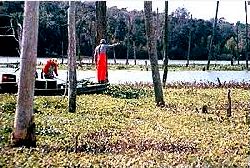
“Now watch how this is done”, Daub instructed. With the bait dangling about 3-4 feet below the rod tip, Daub swung it in a pendulum motion and gently launched the bait toward the edge of the floating vegetation. Just as the wiggling shiner was near plopping down inches from the vegetation, Daub stopped the bait in the air.
“What did you do that for?” I kidded, “Did you make a bad cast?”
“No, I tightened the line for a reason,” he said with authority. “When the baits airborne progress is stopped just before it hits the water, it points the tail-hooked shiners head towards the weeds. The baitfish will usually swim in the direction it’s pointed after hitting the water. And I want it to swim under the ‘safety’ of the weeds.”
After the baitfish hits the water they’ll usually swim anywhere from 1-5 feet back under the floating vegetation. If a bass hasn’t grabbed them by then, let the bait rest a minute or two, then gently twitch the line a few times. This tactic usually spooks the shiner, causing it to go even. further back under the weeds. If you’re in a good area, most shiners will be attacked by then.
Your baitcasting reel should be filled with at least 20-pound test, high visibility line such as Berkleys XT Solar or Golden Stren. A wide spool reel such as a Garcia 6500 is best because line peels out easier than it would on a narrow, deep spool, and is less apt to momentarily hang up, which usually causes a bass to drop the bait.
Visible line allows you to easily follow the shiners path, and when the line really starts peeling out a bass has grabbed the bait. Screw the drag down so it’s hard to pull out. After you engage or “click in” the reel, set the hook with a downward sweep away from the weeds. Keep the rod tip low-some even stick half the rod under the surface-and start cranking after a bass is hooked. This is no place for whippy rods, lighter lines and any type of finesse. May the ‘best man” win…and often the big bass does. A low held rod helps keep the bass down, away from the thick floating vegetation that may cause tangles. Also be aware of shiners that just won’t swim under the vegetation very far. If they swim back out to open water several times discard them and re-bait. Lively shiners are absolutely necessary to pull out line far under the cover. And don’t buy hatchery raised shiners, as they don’t work nearly as well as wild, native shiners.
Although I learned this basic technique in Florida a number of years ago, it has plenty of applications in other parts of the country. Shiners can be run under thick blankets of surface-covering goop in the back end of a reservoir cove in Georgia, or under floating bogs in a Wisconsin flowage. This is also a deadly technique for crappies, walleyes or even pike under certain conditions. But tackle and bait adjustments have to be made for other species. Obviously, a “crappie minnow” isn’t going to pull 10 feet of 20-pound test under some matted cover, especially when stuck with a big hook.
Tail-hooked shiners under matted floating vegetation to reach bass
lurking in the shadows. This deadly Florida tactic will also work in the North.
Don’t spend a lot of time in one spot. If you don’t get any action after two runs-move. If the bass are there it’s very hard for them to resist a struggling tail-hooked shiner.
Key areas to target are back into slots or cuts, or under weedy points. The deeper the water under the cover the better. Isolated amounts of cover concentrate more bass in smaller areas. If the lake has a lot of floating cover, concentrate on a little deeper areas that the wind is blowing into, and where the cover coincides with visible wood or underwater structure such as a creek channel.
Just remember-set the hook downward and keep that bass coming toward the boat. It’s really an exciting and productive way to fish!
